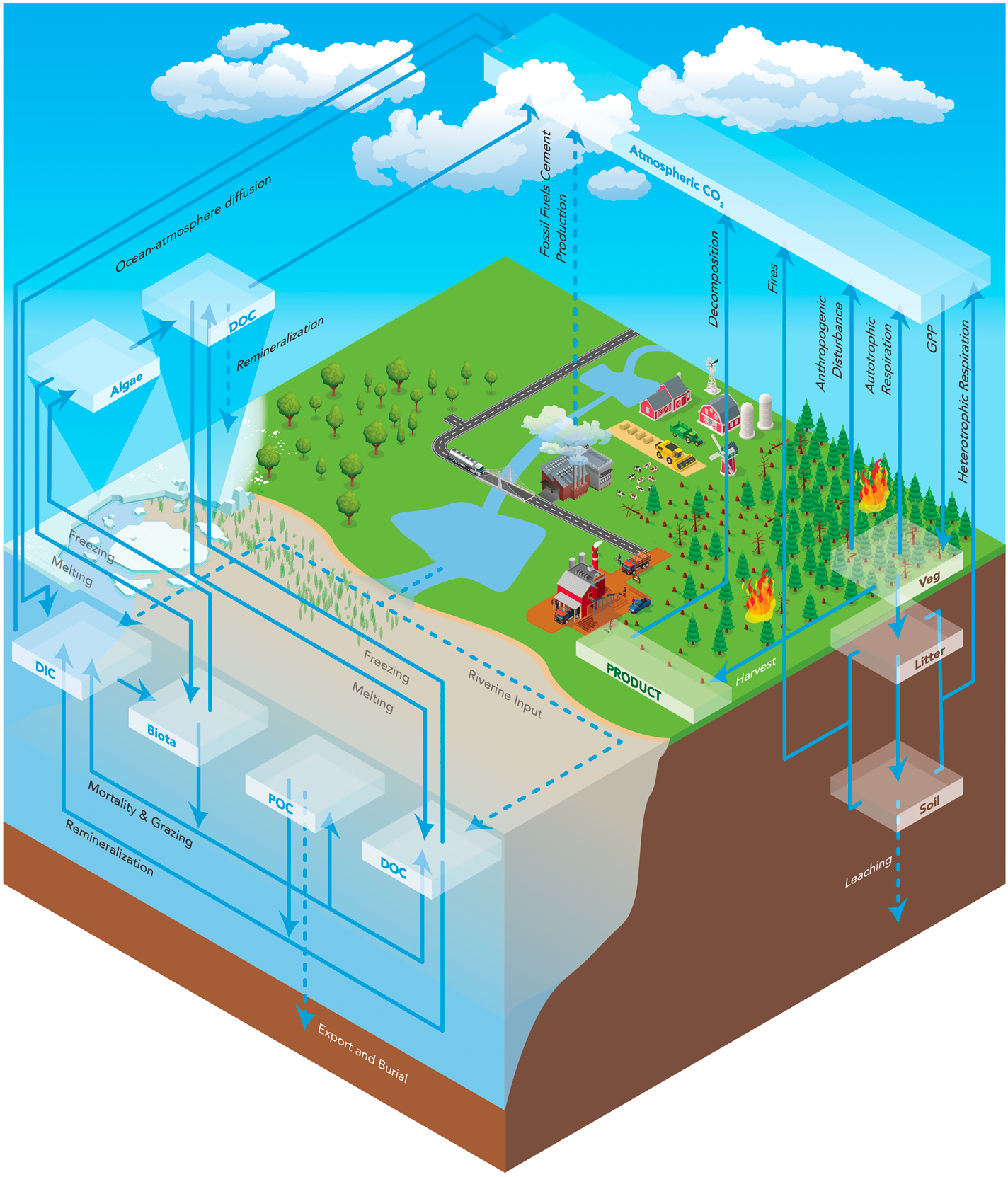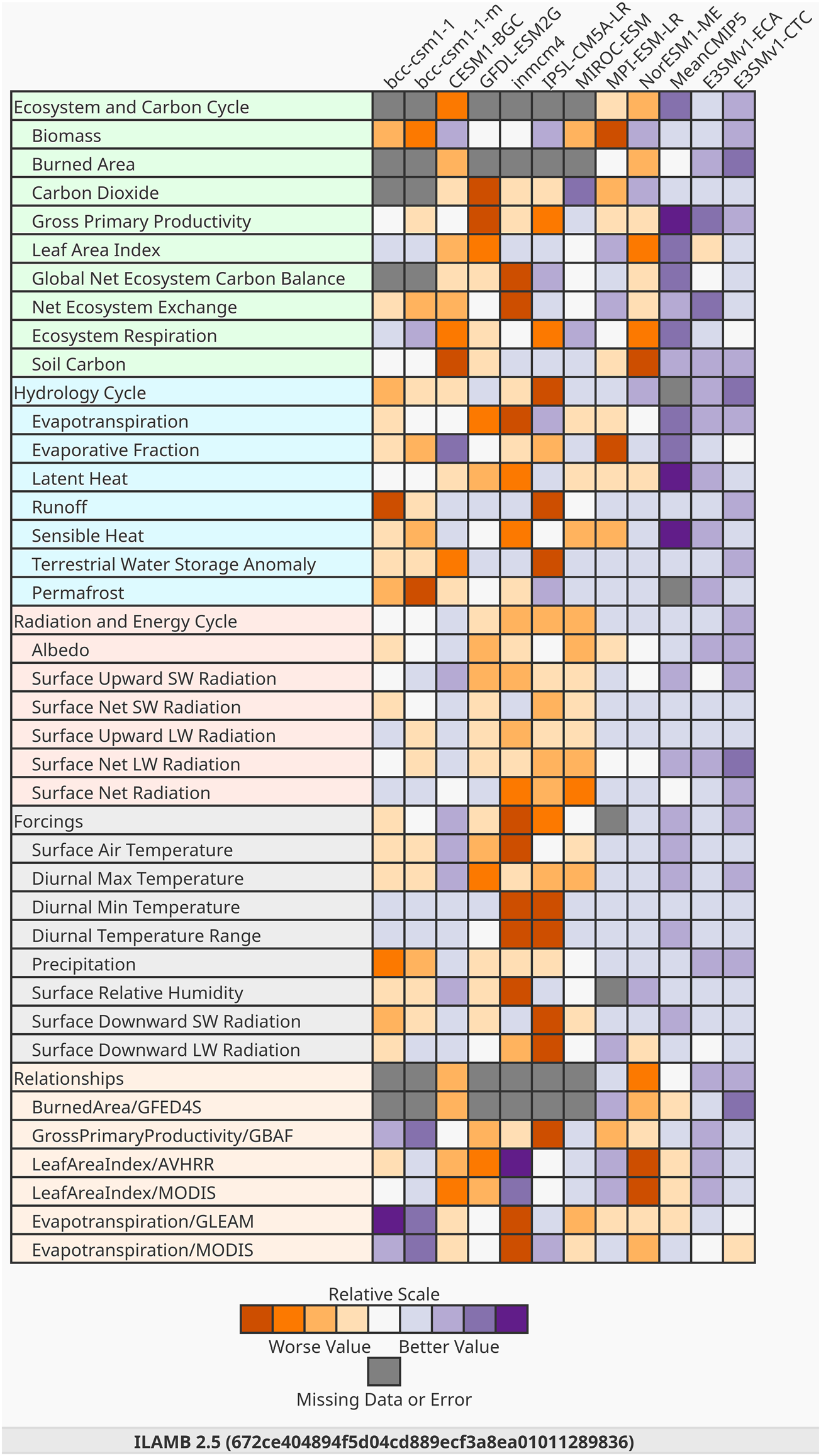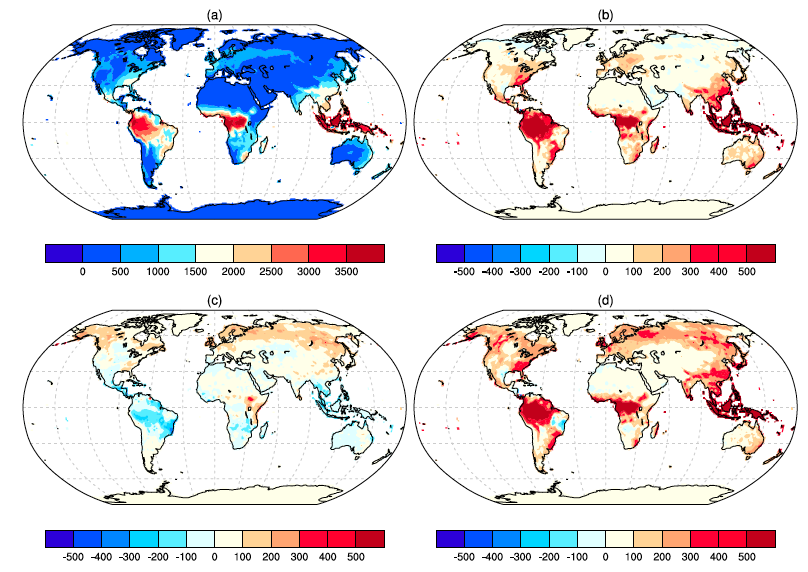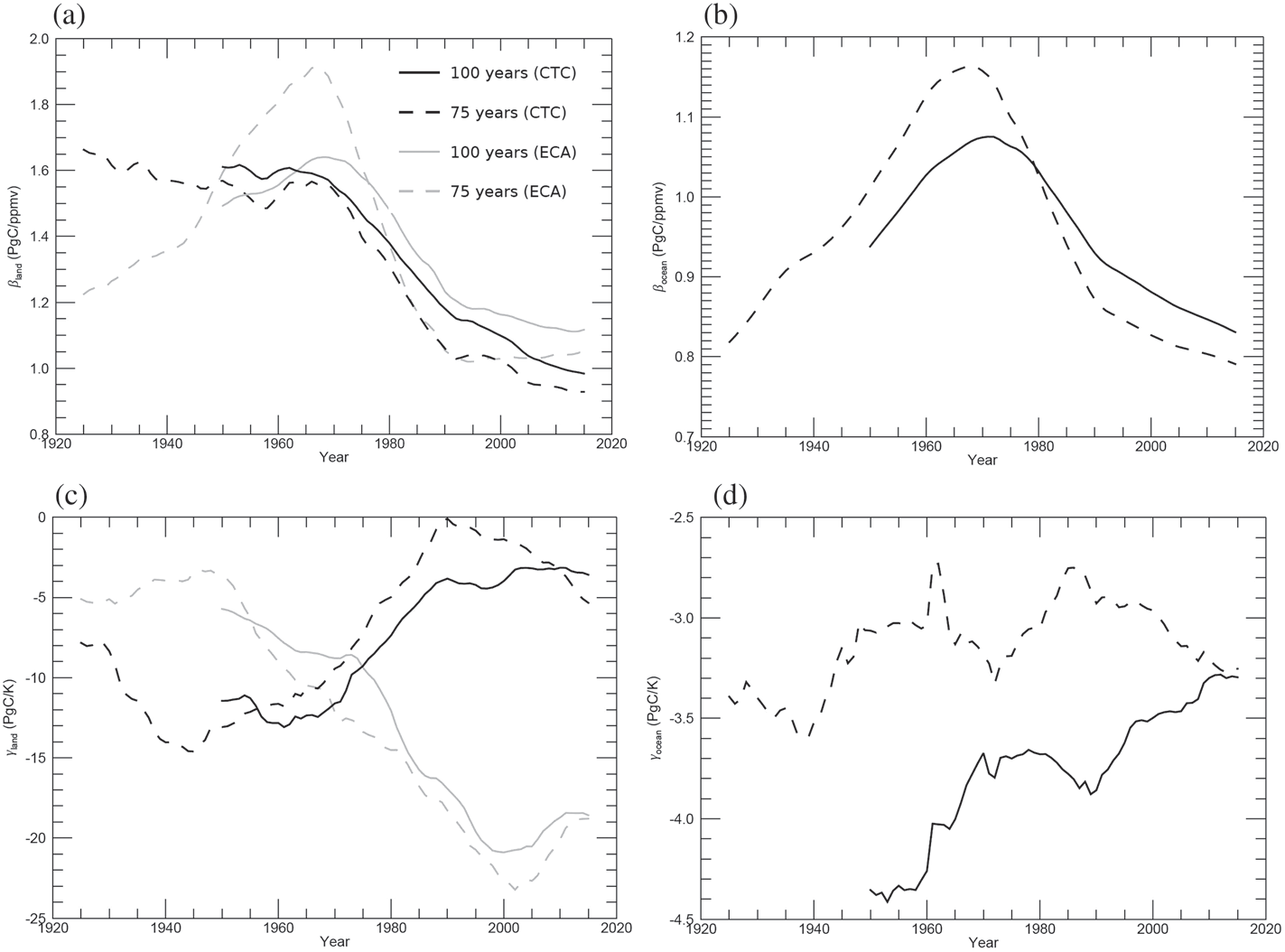E3SM BGC Overview Paper Published

Figure 1. Global carbon cycle in the E3SMv1.1-BGC model, with major carbon pools (boxes) and fluxes (arrows). Dashed lines indicate fluxes that are either prescribed inputs to model carbon pools or losses which are not tracked further in the model.
The DOE E3SM v1.1 Biogeochemistry Configuration: Description and Simulated Ecosystem-Climate Responses to Historical Changes in Forcing.
In August 2020, a paper that documents and evaluates the performance of the E3SM Version 1.1 Biogeochemistry (BGC) configuration was published in the Journal of Advances in Modeling Earth Systems (JAMES) (DOI: 10.1029/2019MS001766).
This paper will serve as the main reference for the E3SMv1.1-BGC model, in particular for the carbon cycle in the E3SMv1.1 land and ocean models, and its response to historical changes in atmospheric carbon dioxide concentrations and climate.
Background
The Energy Exascale Earth System Model (E3SM) project is an ongoing, state-of-the-art Earth system modeling, simulation, and prediction project funded by the Department of Energy (DOE), which was developed to meet the science needs of the nation and the mission needs of DOE (Bader et al., 2014). Golaz et al. (2019) documents the E3SMv1 model (publicly released in April 2018) and evaluates its physical climate in detail.
Simulating the uptake of carbon dioxide (CO2) by the land and ocean is one of the key elements needed to predict long-term changes in the Earth system. E3SMv1.1-BGC was developed to accommodate this type of simulation as well as other biogeochemical processes. E3SMv1.1-BGC adds capabilities essential to simulating the changes in the Earth’s carbon sink that occur in response to atmospheric CO2 concentrations and climate (Fig.1).
E3SM v1.1-BGC Model
E3SMv1.1-BGC is an update to E3SM version 1. The update adds functionality and implements the configurations needed for simulation of historical carbon cycle dynamics.
E3SMv1.1-BGC’s capabilities are demonstrated through a set of experiments described by the Coupled Climate-Carbon Cycle Model Intercomparison Project (C4MIP), which is aimed at understanding the influence of changes in climate and CO2 on the carbon cycle.
Additionally, this paper describes how the model behaves with two different configurations of the land’s carbon cycle. These two approaches, called the Converging Trophic Cascade (CTC) and the Equilibrium Chemistry Approximation (ECA), are compared with each other and with previous models, across a variety of metrics. Comparing model simulations that use these two different approaches provides insights into some of the sources of structural uncertainty affecting the terrestrial carbon cycle, within an otherwise identical Earth system model.

Figure 2. International Land Model Benchmarking (ILAMB) tool results comparing both E3SMv1.1 land model configurations performance (model columns 11–12) to nine CMIP5 land models (model columns 1–9) and the multimodel mean of those CMIP5 models (model column 10). The E3SMv1.1 results were drawn from the concentration-forced (BDRD) CMIP6 historical simulations (Eyring et al., 2016), while the other model results came from the concentration-forced CMIP5 historical simulations (Taylor et al., 2012). The full ILAMB results are publicly available via the interactive online interface.
Summary of the Results
Because the climate of the model was very similar to the E3SMv1 simulations documented in Golaz et al. (2019), the E3SMv1.1-BGC model evaluation focused primarily on the model’s biogeochemical cycles.
The ILAMB benchmarking tool (Collier et al., 2018) was used to compare the land’s biogeochemistry and hydrology with a range of observational benchmarks.
Simulations of the land surface and terrestrial carbon cycle compare well with observations: the model performs better than its ancestor (CESM1-BGC) on most ecosystem and carbon cycle metrics on the ILAMB scorecard. It also performs similarly to, or better than, most of the individual predictions of a collection of previous generation (CMIP5) Earth System models, even outperforming the multimodel mean in some cases (Fig. 2).
Ocean biomass production and carbon uptake are underpredicted (not pictured in Fig. 2), likely due to biases in ocean transport leading to widespread anoxia and undersupply of nutrients to surface waters. The causes of these biases are now being addressed in an ongoing model development effort.
To separately assess the historical impacts of changes in CO2 concentration on the carbon cycle and the impacts of changes in climate on the carbon cycle, a suite of simulations was performed where increases in CO2 were allowed to have either a “concentration” effect or a “climate” effect on the land and ocean ecosystems (Fig. 3 lines 2 and 3, respectively). As atmospheric CO2 concentrations rise, plant photosynthesis is enhanced and absorption of CO2 by the ocean can increase. As a result, less CO2 remains in the atmosphere than would be expected if these “concentration” effects did not exist (Fig. 3, line 2). At the same time, the “climate” effect (Fig. 3, line 3) represents changes in climate variables, including temperature and precipitation, which can impact the amount of terrestrial CO2 uptake – for example, by changing plant growth and soil microbial activity. The “climate” effect in the ocean can manifest itself as 1) changes in ocean CO2 uptake, due to changes in the solubility of CO2 and other gases as the ocean warms, and 2) changes in ocean circulation and sea ice, due to warmer temperatures and changing precipitation patterns, that impact ocean ecosystems and storage of carbon in the deep ocean.
In the E3SMv1.1-BGC coupling scenarios, researchers separately prescribed the CO2 concentrations experienced by biogeochemical systems on land and in the ocean (“B”) and the CO2 concentrations experienced by the atmosphere model’s radiative transfer codes (“R”). In each experiment, the prescribed concentrations of CO2 were either held constant at 1850 levels (“C”) or increased along historical diagnostic (“D”) pathways (as opposed to prognostically simulated based on emissions) (Fig. 3).

Table 1. Table of simulations conducted for quantifying carbon-climate feedbacks, using both the Converging Trophic Cascade (CTC) and the Equilibrium Chemistry Approximation (ECA) representations of terrestrial biogeochemistry. Scientific simulations were conducted for a total of 2925 simulated years in a fully-coupled model, including model initialization (spin-up).

Figure 4. Spatial pattern of annual gross primary productivity (GPP) in E3SMv1.1-BGC simulations, and its response to historical CO2 coupling scenarios: (a) BCRC-hist, (b) physiological effect: BDRC-hist − BCRC-hist, (c) radiative effect: BCRD-hist − BCRC-hist, and (d) full effect: BDRD-hist − BCRC-hist.
The model responds to these different prescribed CO2 scenarios by producing different amounts of plant growth, or gross primary productivity (GPP; Fig. 4a). In simulations where plants are exposed to increasing amounts of CO2, plant growth increases significantly, primarily in regions that are already densely vegetated such as tropical rainforests (Fig. 4b). In contrast, in simulations where plants are exposed to constant CO2 but the climate warms, plant growth increases moderately in colder northern regions such as Siberia and Alaska, where present-day growth is limited by cold temperatures (Fig. 4c). Combined, these two effects lead to an increase in plant productivity over nearly the entire planet (Fig. 4d).
One of the most important goals for a carbon cycle model is an accurate simulation of historical changes in total ecosystem carbon (TEC). In the E3SMv1.1-BGC simulations, TEC declines from 1850 until about 1975, mostly due to changes in land use, but by the year 2008, TEC recovers to about 50 PgC below its 1850 value. This is consistent with observationally-based estimates of pre-industrial to present-day changes in total ecosystem carbon (Khatiwala et al., 2013; Le Quéré et al. 2018).
Using these simulations, the strength of the carbon-climate feedback was also quantified, based on the definitions from Friedlingstein et al. (2006), but calculated using multiyear moving regressions in order to capture the evolution of feedback parameters over time.

Figure 5. Model estimates of land and ocean carbon-climate feedback parameters. (a, b) Temporal variation of land and ocean carbon storage to change in atmospheric CO2 concentration (𝛽 land and 𝛽 ocean, respectively). (c, d) Temporal variation of land and ocean carbon storage to changes in global mean near-surface air temperature (𝛾 land and 𝛾 ocean, respectively). Solid and dashed lines show results for regression windows of length 100 and 75 years, respectively. Black lines show results from E3SMv1.1-BGC simulations (using CTC), while gray lines (in a and c) show ECA results.
Overall, nutrient limitations result in less land carbon uptake compared to models that exclude these limitations (Arora et al., 2013, 2020; Thornton et al., 2009), consistent with the so-called “progressive nutrient limitation hypothesis” (Luo et al., 2004). However, variations in model structure and initialization influence the magnitude of those limitations and carbon cycle dynamics, so that results using the default CTC configuration and the alternative ECA configuration are similar in their concentration-carbon feedback (Fig. 5a) but different in their climate-carbon feedbacks (Fig. 5c).
Future versions of E3SM, e.g., E3SMv2, will include E3SM’s first attempted simulations of atmospheric CO2, enabling atmospheric concentrations to dynamically respond to fossil fuel emissions, as well as to changes in land and ocean surface fluxes. Additionally, E3SMv2 will incorporate capabilities to dynamically couple with the Global Change Analysis Model (GCAM), which simulates the energy system’s response to climate variables. These new directions will allow E3SM to better support energy sector decisions and address science questions central to the Department of Energy’s mission.
Publication
- S. M. Burrows, M. Maltrud, X. Yang, Q. Zhu, N. Jeffery, X. Shi and co-authors (2020). The DOE E3SM v1.1 biogeochemistry configuration: description and simulated ecosystem‐climate responses to historical changes in forcing. Journal of Advances in Modeling Earth Systems, 12. https://doi.org/10.1029/2019MS001766
E3SM Code
- E3SMv1.1 code (used for default CTC configuration): https://www.osti.gov/doecode/biblio/42003
- E3SMv1.1.1 code (used for alternative ECA configuration): https://www.osti.gov/doecode/biblio/42008
E3SM ILAMB Benchmarking Results
- Web interface to ILAMB benchmarking results: https://www.ilamb.org/ELM/ilamb_e3sm_cbgcv1/
- Download the ILAMB benchmarking results (version of record): https://figshare.com/articles/ILAMBv2_5_benchmarking_results_comparing_E3SMv1_1_CMIP6_historical_simulations_with_multi-model_CMIP5_historical_simulations/11097356
E3SM Data
- E3SMv1.1 Data on ESGF: https://esgf-node.llnl.gov/search/cmip6/?source_id=E3SM-1-1
- E3SMv1.1-ECA Data on ESGF: https://esgf-node.llnl.gov/search/cmip6/?source_id=E3SM-1-1-ECA
- All E3SM Data on ESGF: https://esgf-node.llnl.gov/projects/e3sm/
Contact
Susannah Burrows
Pacific Northwest National Laboratory
susannah.burrows@pnnl.gov



